Abstract
OBJECTIVE--To examine the cardioprotective efficacy of allopurinol in patients undergoing elective coronary artery surgery. DESIGN--Prospective randomised trial. SETTING--London teaching hospital. PATIENTS--Twenty patients with at least moderately good left ventricular function undergoing elective coronary artery surgery and requiring at least two bypass grafts. INTERVENTIONS--Patients were randomised to receive allopurinol (1200 mg in two divided doses) or to act as controls. MAIN OUTCOME MEASURE--The primary determinant of the efficacy of myocardial protection was serial measurement (preoperatively and subsequently at one, six, 24, and 72 hours after the end of cardiopulmonary bypass) of cardiac troponin T (cTnT) a highly sensitive and specific marker of myocardial damage. Additional evidence was provided by serial measurement of the MB-isoenzyme of creatine kinase (CK-MB) and myoglobin, ECG changes, and clinical outcome. RESULTS--There was no significant difference in age, ejection fraction, number of grafts, bypass times, or cross clamp times between the two groups. In both groups there was a highly significant (p < 0.01) rise in cTnT, CK-MB, and myoglobin. Peak concentrations were reached between one (CK-MB and myoglobin) and six hours (cTnT) after the end of cardiopulmonary bypass. At 72 hours cTnT concentrations were six times higher than baseline concentrations whereas CK-MB and myoglobin were approximately double baseline concentrations. There was no significant difference in cTnT, CK-MB, or myoglobin between the allopurinol and control groups at any time. There was no diagnostic ECG evidence of perioperative infarction in any patient. CONCLUSION--Unlike previous reports this study did not show that allopurinol had a cardioprotective effect in patients with good left ventricular function undergoing elective coronary artery surgery.
Full text
PDF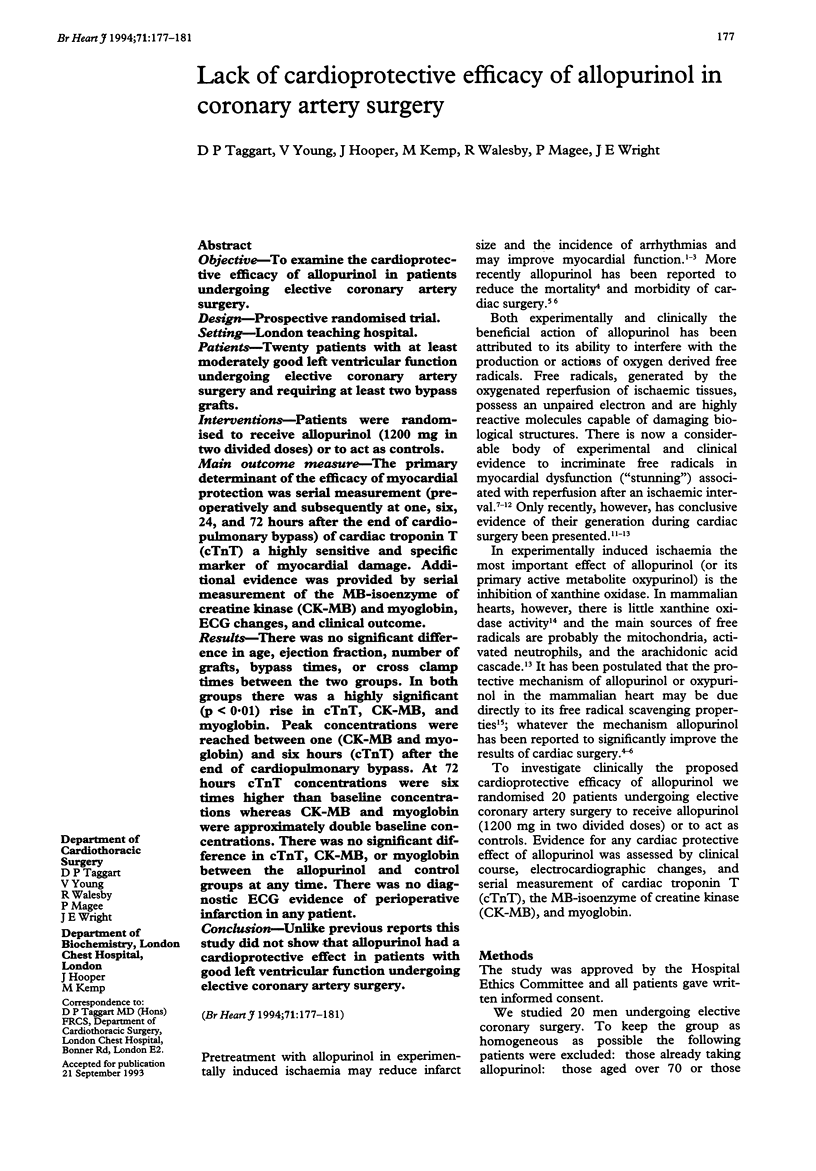
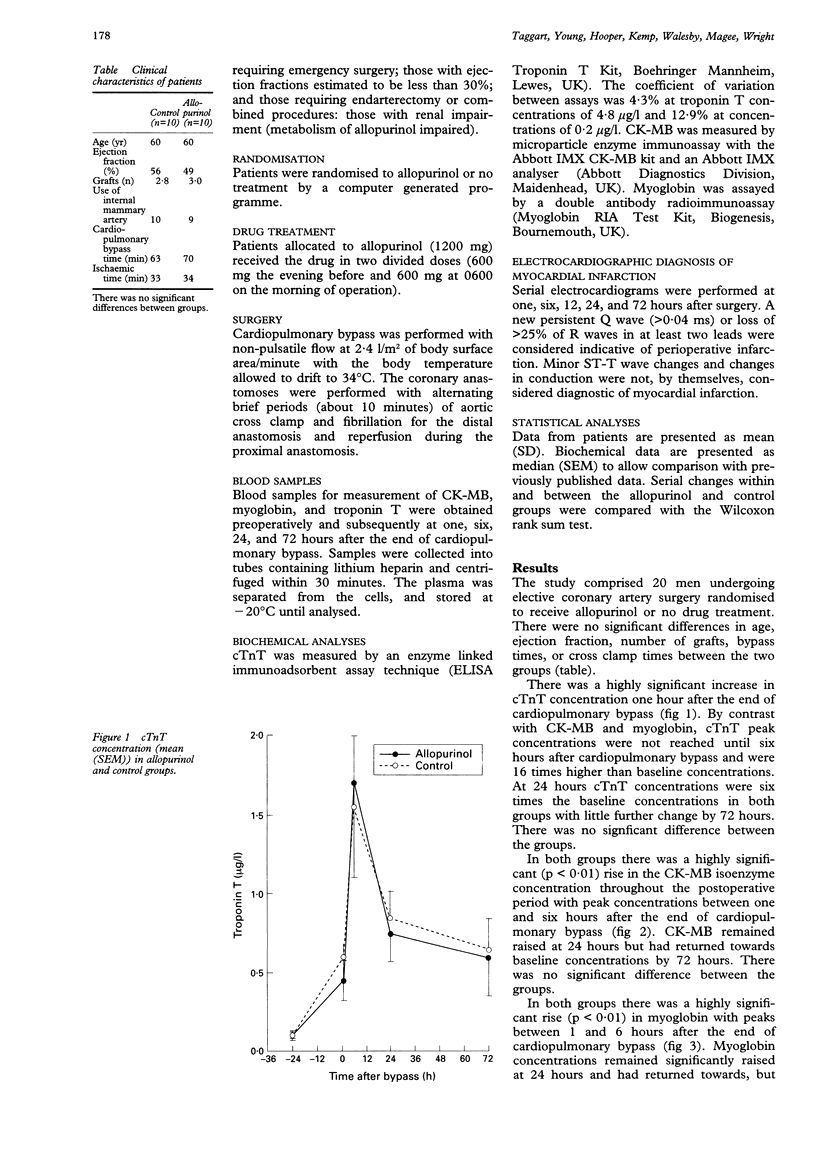
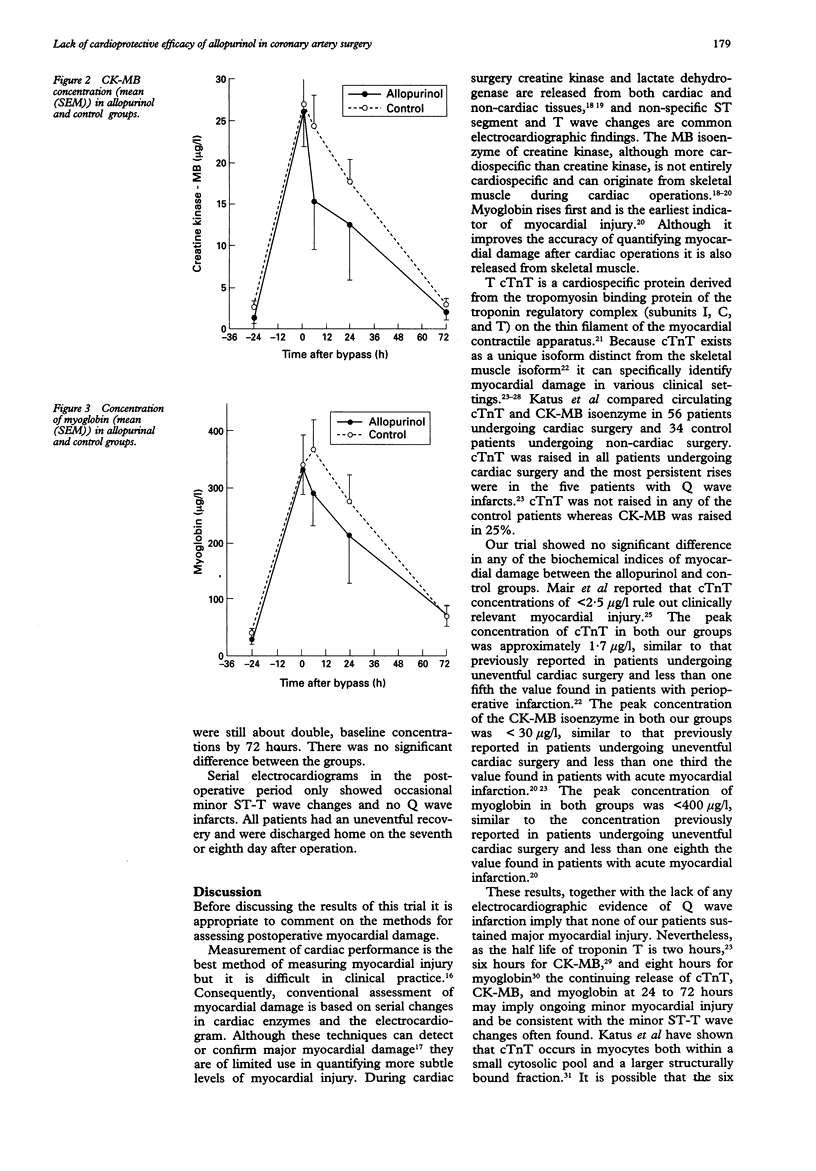
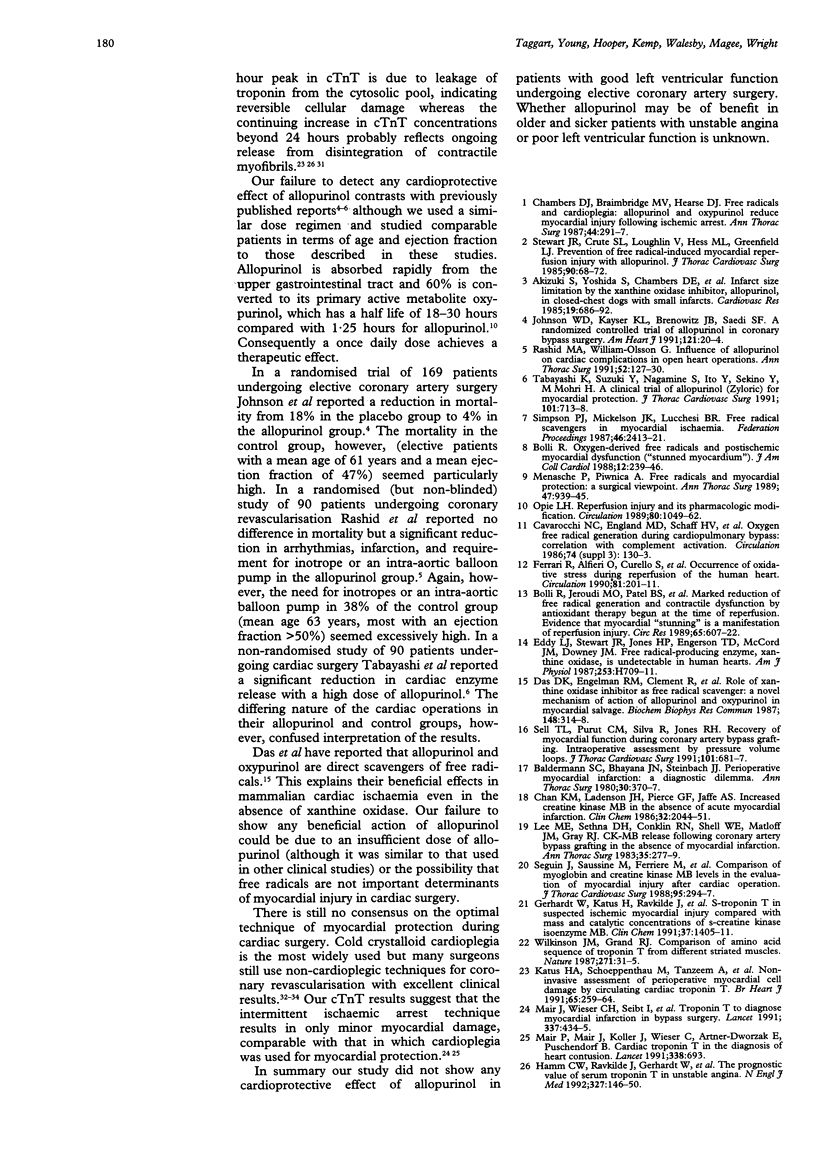
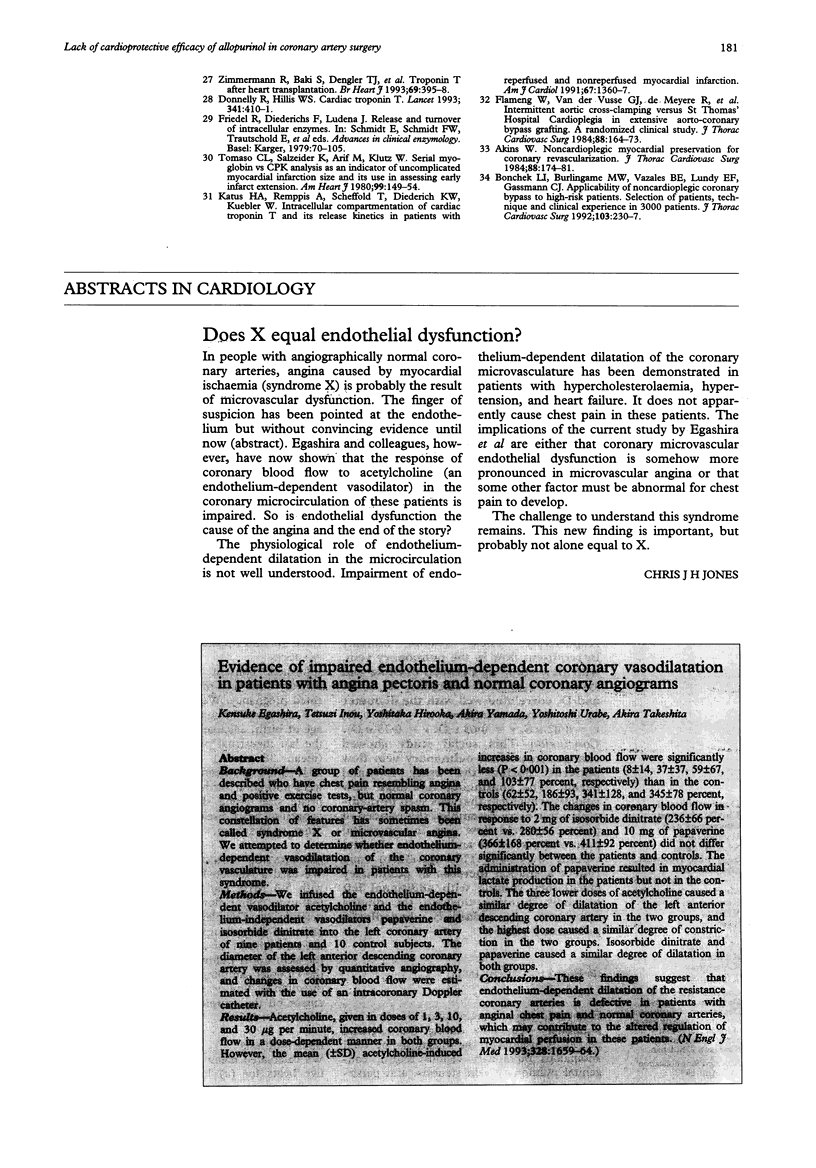
Selected References
These references are in PubMed. This may not be the complete list of references from this article.
- Akins C. W. Noncardioplegic myocardial preservation for coronary revascularization. J Thorac Cardiovasc Surg. 1984 Aug;88(2):174–181. [PubMed] [Google Scholar]
- Akizuki S., Yoshida S., Chambers D. E., Eddy L. J., Parmley L. F., Yellon D. M., Downey J. M. Infarct size limitation by the xanthine oxidase inhibitor, allopurinol, in closed-chest dogs with small infarcts. Cardiovasc Res. 1985 Nov;19(11):686–692. doi: 10.1093/cvr/19.11.686. [DOI] [PubMed] [Google Scholar]
- Balderman S. C., Bhayana J. N., Steinbach J. J., Masud A. R., Michalek S. Perioperative myocardial infarction: a diagnostic dilemma. Ann Thorac Surg. 1980 Oct;30(4):370–377. doi: 10.1016/s0003-4975(10)61277-5. [DOI] [PubMed] [Google Scholar]
- Bolli R., Jeroudi M. O., Patel B. S., Aruoma O. I., Halliwell B., Lai E. K., McCay P. B. Marked reduction of free radical generation and contractile dysfunction by antioxidant therapy begun at the time of reperfusion. Evidence that myocardial "stunning" is a manifestation of reperfusion injury. Circ Res. 1989 Sep;65(3):607–622. doi: 10.1161/01.res.65.3.607. [DOI] [PubMed] [Google Scholar]
- Bolli R. Oxygen-derived free radicals and postischemic myocardial dysfunction ("stunned myocardium"). J Am Coll Cardiol. 1988 Jul;12(1):239–249. doi: 10.1016/0735-1097(88)90381-6. [DOI] [PubMed] [Google Scholar]
- Bonchek L. I., Burlingame M. W., Vazales B. E., Lundy E. F., Gassmann C. J. Applicability of noncardioplegic coronary bypass to high-risk patients. Selection of patients, technique, and clinical experience in 3000 patients. J Thorac Cardiovasc Surg. 1992 Feb;103(2):230–237. [PubMed] [Google Scholar]
- Chambers D. J., Braimbridge M. V., Hearse D. J. Free radicals and cardioplegia: allopurinol and oxypurinol reduce myocardial injury following ischemic arrest. Ann Thorac Surg. 1987 Sep;44(3):291–297. doi: 10.1016/s0003-4975(10)62076-0. [DOI] [PubMed] [Google Scholar]
- Das D. K., Engelman R. M., Clement R., Otani H., Prasad M. R., Rao P. S. Role of xanthine oxidase inhibitor as free radical scavenger: a novel mechanism of action of allopurinol and oxypurinol in myocardial salvage. Biochem Biophys Res Commun. 1987 Oct 14;148(1):314–319. doi: 10.1016/0006-291x(87)91112-0. [DOI] [PubMed] [Google Scholar]
- Donnelly R., Hillis W. S. Cardiac troponin T. Lancet. 1993 Feb 13;341(8842):410–411. doi: 10.1016/0140-6736(93)92996-7. [DOI] [PubMed] [Google Scholar]
- Eddy L. J., Stewart J. R., Jones H. P., Engerson T. D., McCord J. M., Downey J. M. Free radical-producing enzyme, xanthine oxidase, is undetectable in human hearts. Am J Physiol. 1987 Sep;253(3 Pt 2):H709–H711. doi: 10.1152/ajpheart.1987.253.3.H709. [DOI] [PubMed] [Google Scholar]
- Flameng W., Van der Vusse G. J., De Meyere R., Borgers M., Sergeant P., Vander Meersch E., Geboers J., Suy R. Intermittent aortic cross-clamping versus St. Thomas' Hospital cardioplegia in extensive aorta-coronary bypass grafting. A randomized clinical study. J Thorac Cardiovasc Surg. 1984 Aug;88(2):164–173. [PubMed] [Google Scholar]
- Gerhardt W., Katus H., Ravkilde J., Hamm C., Jørgensen P. J., Peheim E., Ljungdahl L., Löfdahl P. S-troponin T in suspected ischemic myocardial injury compared with mass and catalytic concentrations of S-creatine kinase isoenzyme MB. Clin Chem. 1991 Aug;37(8):1405–1411. [PubMed] [Google Scholar]
- Hamm C. W., Ravkilde J., Gerhardt W., Jørgensen P., Peheim E., Ljungdahl L., Goldmann B., Katus H. A. The prognostic value of serum troponin T in unstable angina. N Engl J Med. 1992 Jul 16;327(3):146–150. doi: 10.1056/NEJM199207163270302. [DOI] [PubMed] [Google Scholar]
- Johnson W. D., Kayser K. L., Brenowitz J. B., Saedi S. F. A randomized controlled trial of allopurinol in coronary bypass surgery. Am Heart J. 1991 Jan;121(1 Pt 1):20–24. doi: 10.1016/0002-8703(91)90950-m. [DOI] [PubMed] [Google Scholar]
- Katus H. A., Remppis A., Scheffold T., Diederich K. W., Kuebler W. Intracellular compartmentation of cardiac troponin T and its release kinetics in patients with reperfused and nonreperfused myocardial infarction. Am J Cardiol. 1991 Jun 15;67(16):1360–1367. doi: 10.1016/0002-9149(91)90466-x. [DOI] [PubMed] [Google Scholar]
- Lee M. E., Sethna D. H., Conklin C. M., Shell W. E., Matloff J. M., Gray R. J. CK-MB release following coronary artery bypass grafting in the absence of myocardial infarction. Ann Thorac Surg. 1983 Mar;35(3):277–279. doi: 10.1016/s0003-4975(10)61559-7. [DOI] [PubMed] [Google Scholar]
- Mair P., Mair J., Koller J., Wieser C., Artner-Dworzak E., Puschendorf B. Cardiac troponin T in the diagnosis of heart contusion. Lancet. 1991 Sep 14;338(8768):693–693. doi: 10.1016/0140-6736(91)91266-w. [DOI] [PubMed] [Google Scholar]
- Menasché P., Piwnica A. Free radicals and myocardial protection: a surgical viewpoint. Ann Thorac Surg. 1989 Jun;47(6):939–945. doi: 10.1016/0003-4975(89)90047-7. [DOI] [PubMed] [Google Scholar]
- Opie L. H. Reperfusion injury and its pharmacologic modification. Circulation. 1989 Oct;80(4):1049–1062. doi: 10.1161/01.cir.80.4.1049. [DOI] [PubMed] [Google Scholar]
- Pierce G. F., Jaffe A. S. Increased creatine kinase MB in the absence of acute myocardial infarction. Clin Chem. 1986 Nov;32(11):2044–2051. [PubMed] [Google Scholar]
- Rashid M. A., William-Olsson G. Influence of allopurinol on cardiac complications in open heart operations. Ann Thorac Surg. 1991 Jul;52(1):127–130. doi: 10.1016/0003-4975(91)91433-v. [DOI] [PubMed] [Google Scholar]
- Simpson P. J., Mickelson J. K., Lucchesi B. R. Free radical scavengers in myocardial ischemia. Fed Proc. 1987 May 15;46(7):2413–2421. [PubMed] [Google Scholar]
- Stewart J. R., Crute S. L., Loughlin V., Hess M. L., Greenfield L. J. Prevention of free radical-induced myocardial reperfusion injury with allopurinol. J Thorac Cardiovasc Surg. 1985 Jul;90(1):68–72. [PubMed] [Google Scholar]
- Séguin J., Saussine M., Ferrière M., Sany C., Coulon P., Grolleau R., Chaptal P. A. Comparison of myoglobin and creatine kinase MB levels in the evaluation of myocardial injury after cardiac operations. J Thorac Cardiovasc Surg. 1988 Feb;95(2):294–297. [PubMed] [Google Scholar]
- Tabayashi K., Suzuki Y., Nagamine S., Ito Y., Sekino Y., Mohri H. A clinical trial of allopurinol (Zyloric) for myocardial protection. J Thorac Cardiovasc Surg. 1991 Apr;101(4):713–718. [PubMed] [Google Scholar]
- Tommaso C. L., Salzeider K., Arif M., Klutz W. Serial myoglobin vs. CPK analysis as an indicator of uncomplicated myocardial infarction size and its use in assessing early infarct extension. Am Heart J. 1980 Feb;99(2):149–154. doi: 10.1016/0002-8703(80)90759-0. [DOI] [PubMed] [Google Scholar]
- Wilkinson J. M., Grand R. J. Comparison of amino acid sequence of troponin I from different striated muscles. Nature. 1978 Jan 5;271(5640):31–35. doi: 10.1038/271031a0. [DOI] [PubMed] [Google Scholar]
- Zimmermann R., Baki S., Dengler T. J., Ring G. H., Remppis A., Lange R., Hagl S., Kübler W., Katus H. A. Troponin T release after heart transplantation. Br Heart J. 1993 May;69(5):395–398. doi: 10.1136/hrt.69.5.395. [DOI] [PMC free article] [PubMed] [Google Scholar]


